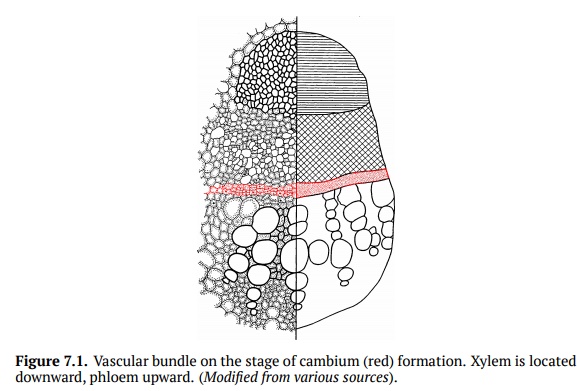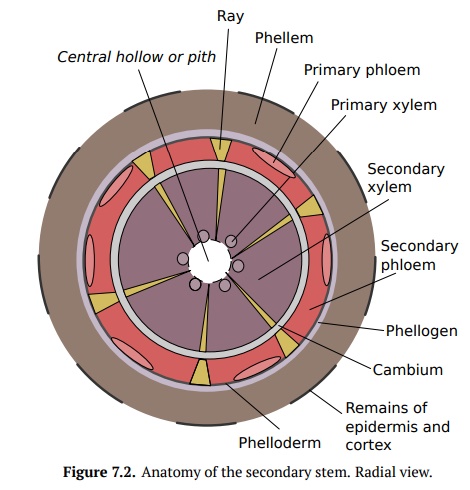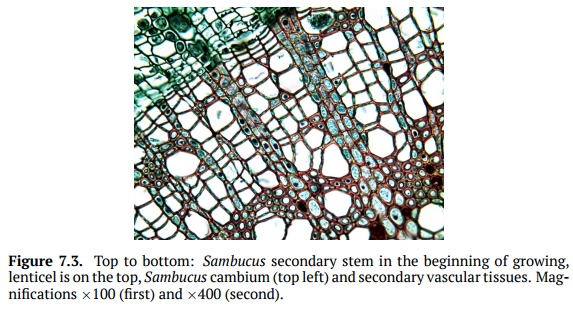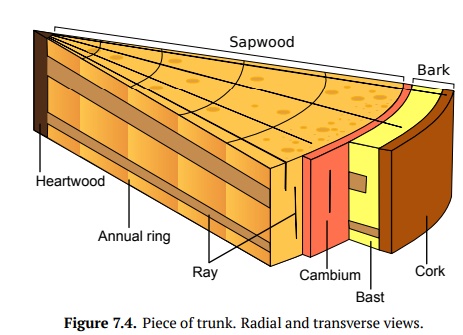Chapter: Introduction to Botany: The Origin of Trees and Seeds
Secondary Stem
Secondary Stem
In many seed plants,
secondary growth begins in their first year within the stem and continues on
for many more years. These plants are classified as woody. They develop secondary
tissues like periderm and wood, and even tertiary struc-tures like bark.

The first step in
producing secondary phloem and xylem is to form the vascular cambium, which
involves cell division inside the vascular bundles and the pa-renchyma that are
between the bundles (Fig. 7.1). The vascular
cambium divides in two directions. The cells that are formed to the outside
become the secondaryphloem, and those
formed to the inside are the secondary
xylem (Fig.7.3). Af-ter several years,
central pith disappears under the pressure of growing wood,and only traces of
primary xylem can be seen under the
thick secondary xylem. Altogether, these tissues (pith + primary xylem +
secondary xylem) are wood (Fig. 7.2). The secondary phloem forms outside of the
vascular cambium. It is rich in fibers, and unlike the wood, it does not form
annual rings.

Most of cambium cells
are fusiform initials forming axial
vessel elements, while some cambium cells are ray initials and they form rays:
combinations of paren-chyma cells and tracheids transporting water and minerals
horizontally. Rays are visible best
on the tangential section of the
stem (when section plane is tan-gent to the stem surface); two other possible sections
(radial and transverse) show axial components of the stem better. In the
secondary phloem, rays are sometimes dilated
(wedge-shaped).


The cambium does not
work evenly. In temperate climates, a ring
forms for each growing season and makes it possible to determine the age by
counting the growth rings. This is because at the end of season cambium makes
much smaller (“darker”) tracheary elements. Trees growing in climates without
well-expressed seasons will not make annual rings. To tell the age of a tree,
re-searchers observe the number and thickness of annual rings that are formed.
This is called dendrochronology.
Some trees (like oaks,
Quercus) have large vessel elements
are found primarily in the wood formed early in the season (early wood); this
pattern is known as ringporous.
Large vessel elements of other trees (like elm,Ulmus) occur more evenlyin both early and late wood. This pattern
is known as diffuse porouswood: with
large vessel elements in both early and late wood.
Vesselless wood of
conifers is of a simpler structure with relatively few cell types. There are
simple rays and frequently resin ducts;
resin is secreted by specialized cells.
In the tree trunk, the
lighter wood near the periphery is called sapwood
and has functioning xylem where most of the water and minerals are transported.

Darker wood closer to
the center is called heartwood and
is a non-functional, darkly colored xylem (Fig. 7.4).
Tracheary elements are dead cells and to block them, plants uses tyloses which also help control winter
functioning of vessels. A tylose forms when a cell wall of parenchyma grows
through a pit or opening into the tracheary element; they look like bubbles.
Most liliids (for
example, palms) do not have lateral meristems and true wood. Some thickening
does occur in a palm but this happens at the base of the tree, as a result of
adventitious roots growing. Palms may also have diffuse secondary growth which
is division and enlargement of some parenchyma cells. These pro-cesses do not
compensate the overall growth of plant, and palms frequently are thicker on the
top than on the bottom. Few other liliids (like dragon blood tree, Dracaena) haveanomalous secondary growthwhich employs cambium butthis cambium
does not form the stable ring.
Bark is everything outside vascular cambium. It is unique
structure which is some-times called “tertiary tissue” because it consists of
primary and secondary tissues together:
•
trunk = wood + vascular cambium (“cambium”) + bark
•
wood = secondary xylem + primary xylem + [pith]
•
bark = bast (primary + secondary phloem)+periderm+[cortex]+[epidermis]
•
periderm = [phelloderm] + cork cambium (phellogen) + cork (phellem)
Each year, a new layer
of phellogen (cork cambium) appears from the parenchy-ma cells of the secondary
phloem which makes bark multi-layered and uneven. On the surface of a young
stem, one may see lenticels,
openings in phellem layer which supply the internals of the stem with oxygen.
To produce lenticels, some phellogen cells divide and grow much faster which
will finally break the periderm open.
Apart from the
lenticels, older or winter stems have leaf
scars with leaf traces on their
surface. The first are places where leaf petiole was attached, and the second
are places where vascular bundles entered the leaf.
The secondary
structure of root reminds the secondary structure of stem, and with time, these
two organs become anatomically similar.
Related Topics